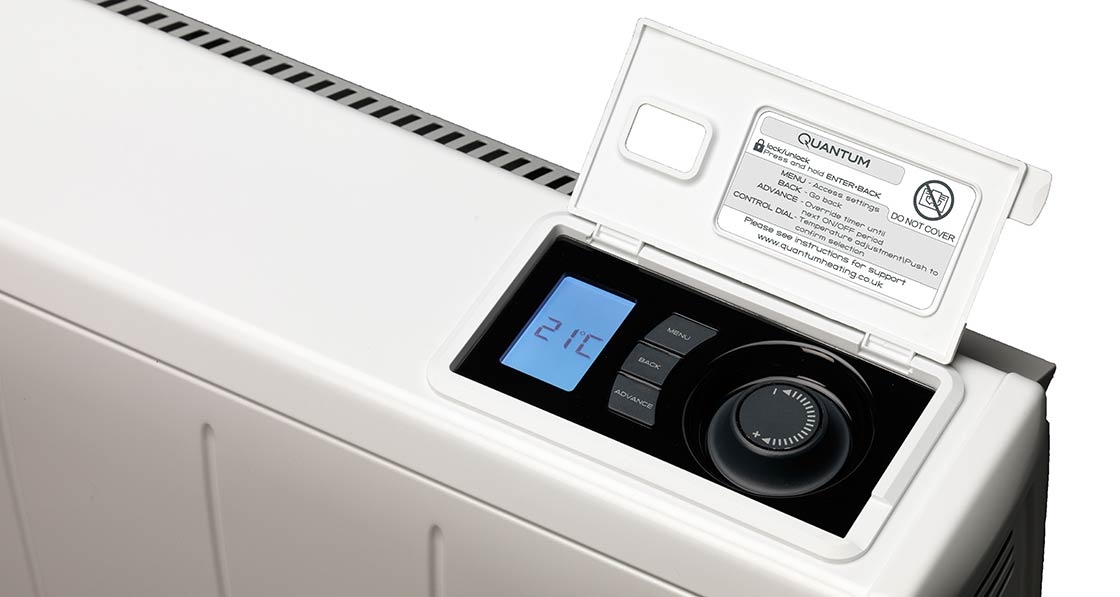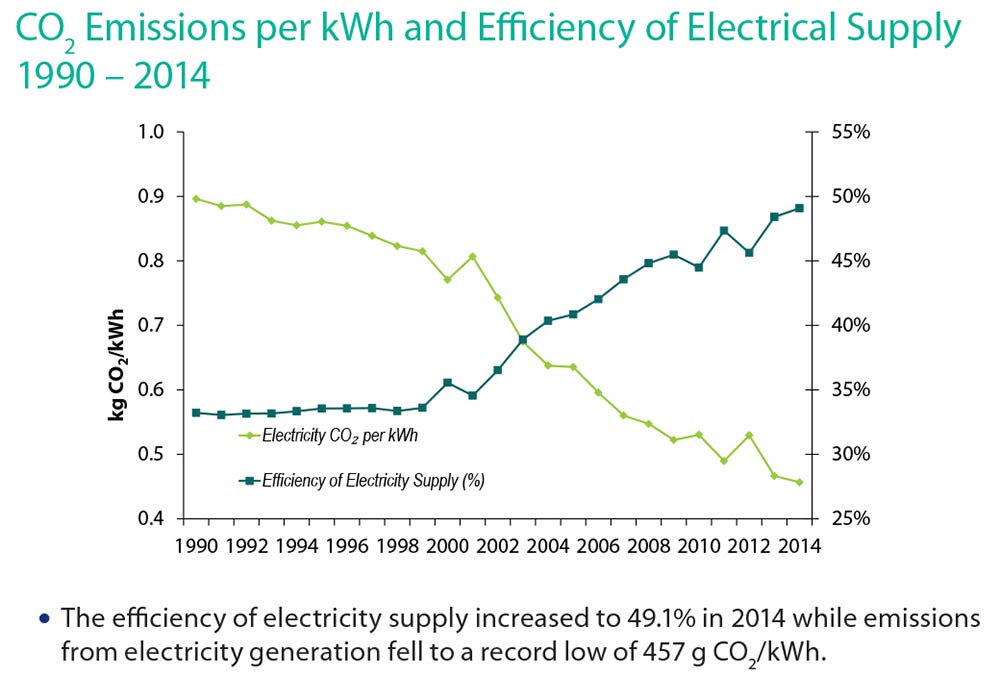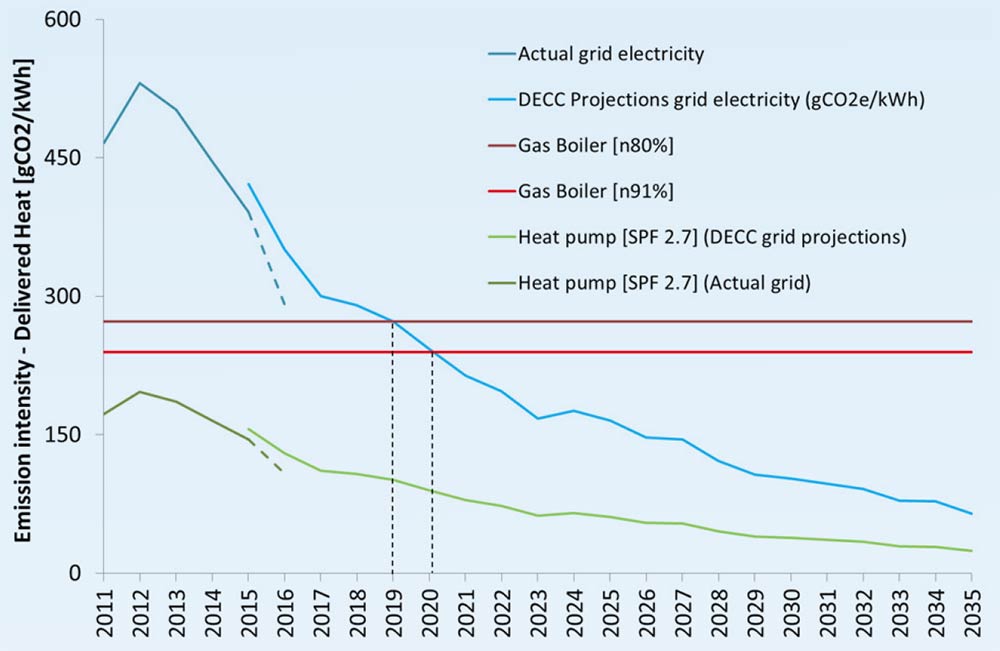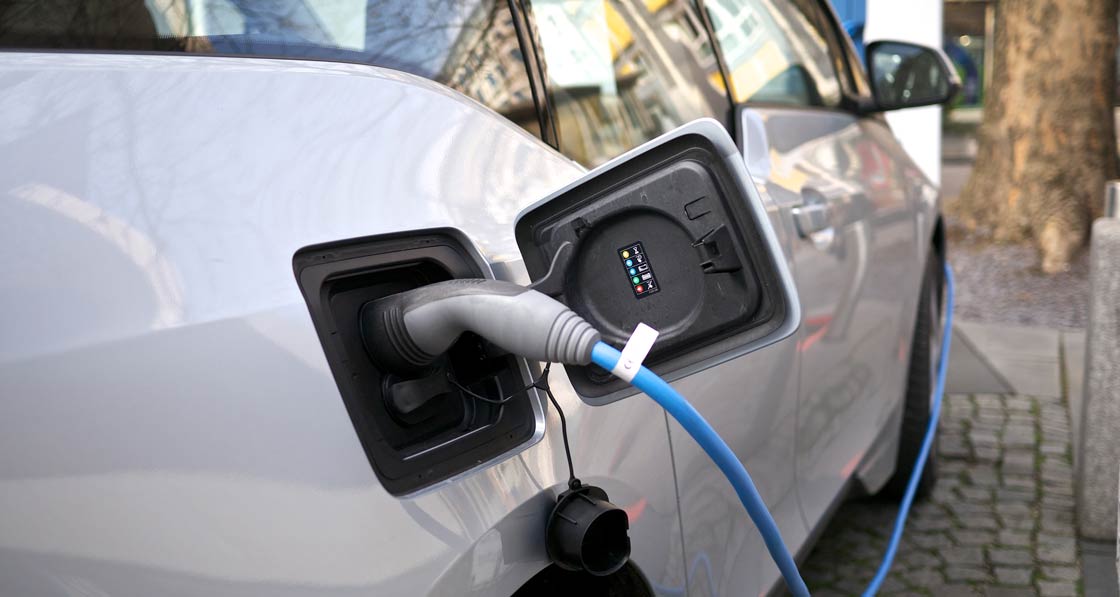
- Insight
- Posted
Together in Electric Dreams
The gradual decarbonisation of our electricity grids — as renewable energy is phased in, while coal and peat are phased out — coupled with the proliferation of new buildings with very limited heat demand, has some experts asking if heating our homes and offices directly with electricity is starting to make sense again. So is it time to bring back the dreaded storage heater?
This article was originally published in issue 19 of Passive House Plus magazine. Want immediate access to all back issues and exclusive extra content? Click here to subscribe for as little as €10, or click here to receive the next issue free of charge
If we want to keep the planet liveable, we have to dramatically cut the amount of energy buildings use — and dramatically cut the carbon emissions from the energy demand that’s left.
Good building fabric design (and refurbishment) dramatically cuts the need for heat, but in the UK and Ireland even passive buildings usually need some heat — and of course all dwellings need hot water. This means that heat has to be decarbonised, even in a passive house.
While there are well-established technologies to produce electricity without fossil fuels, heat has yet to decarbonise in the same way. Various reports on this topic recommend expansion of low carbon networked heat and possibly the decarbonisation of gas (for example, by synthesising hydrogen via electrolysis using renewable power).
But these technologies are still underdeveloped. Synthetic gas is not produced anywhere at scale, while networked heat still tends to be powered by relatively high-emissions technologies, such as CHP and biomass. However, the most common proposed means of decarbonising heat is through electrification.
Electrification of heat raises a number of questions about the ability of our power systems to produce enough low carbon electricity and their capacity to transmit it (which I’ll get to shortly). But it also represents something of a u-turn in building services design.
Electricity in Ireland and the UK is still generated in large part from burning fossil fuels, including some high-carbon coal and peat, in power stations that lose more than half their energy as heat. For this reason electric heating, particularly direct electric heating, has had a well-deserved reputation for being high carbon and inefficient.
The high carbon emissions, and relative inefficiency, of electricity generation is recognised by the classic passive house standard, for which the high primary energy factor of grid electricity makes it hard to meet the standard using direct electric heat.
On top of the carbon and primary energy cost, direct electric heating — often by storage heaters — is notorious as a system that is cheap for a developer or landlord to install, but expensive and ineffective for occupants.
Upgrading a house from storage heaters to gas central heating is still one of the most basic and widely accepted energy retrofit measures, especially when helping people in fuel poverty.
Heat pumps can overcome many of these issues, with the efficiency of a good unit more than making up for the losses at the power station. However heat pumps tend to be expensive, and if badly specified and set up, can leave users with high bills and/or cold buildings.
Gas combi boiler systems — familiar, cheap and simple to install — offer a comparable Sap score to a heat pump, and remain the default choice in UK residential construction when gas is available. (Ed — In Ireland, where a renewable energy contribution is mandatory under building regulations, heat pumps are becoming an increasingly popular choice. Data from SEAI’s National BER Research Tool indicates that 28% of new homes built to date to the 2011 version of Part L use a heat pump as their main heating system, and anecdotal evidence is that this figure has increased dramatically recently due to more favourable treatment of heat pumps in the national methodology for calculating compliance with Part L, Deap).
Gas boilers have been a popular choice for passive homes as well, and LPG boilers (slightly higher carbon than natural gas) are sometimes specified where there is no mains gas, again, partly because of the simplicity and familiarity of the technology.

But with electricity grids decarbonising as more renewables come on stream, is it time to open our minds to electric heating once again?
Electricity decarbonisation is certainly under way. In Ireland the grid intensity has dropped from 0.642kgCO2/kWh to 0.473kgCO2/kWh since 2004. In the UK the grid average fell from 0.500kgCO2/kWh at the start of this decade to 391g/kWh in 2015. Sap 2012, with its allocated grid intensity of 0.519kgCO2/ kWh, is already strikingly out of date in the UK.
With grid intensities falling, electric heating becomes less of a no-no. Although they may only ‘break even’ with gas in Sap, in reality heat pumps are now actually pretty low carbon. With a very achievable CoP of 2.5, a heat pump in the UK produces heat at around 0.150kgCO2/kWh. This is distinctly lower carbon than gas which, in a good modern boiler, emits around 0.220 to 0.240kgCO2/ kWh delivered heat. Similarly, although grid carbon is higher in Ireland, a heat pump with a CoP of 2.5 still offers heat at around 0.180kgCO2/kWh — a bit better than gas, and definitely an improvement on oil.
But heat pumps can be expensive. And if your building uses very little heat, is it really worth going to the expense and trouble of a heat pump installation, when direct electric heat is so simple and cheap to install? After all, grid electricity will continue to decarbonise. Another issue with heat pumps is that when a building user has solar PV panels fitted, he or she naturally wants to make the most of the free electricity produced. One obvious way, especially if the building’s occupants are out during the day, is to heat the space or the hot water for use later on. Heat pumps can be wired up to respond to signals from PV generation, but this is not a well-developed technology, and because heat pumps shouldn’t really be cycled on and off too much, these systems need quite sophisticated controls.
By the time you have specified a heat pump and some controls that will talk to your PV — plus the correct emitters and a big low-temperature heat store to maximise your heat pump’s CoP — you may have a lot of expensive (and possibly bulky) kit.
If heat demand is so low, is it possible there could be a case for the much simpler and cheaper approach of supplying direct electric heat for space and hot water? This might sound shocking — after all, grid CO2 averages even in the UK are still higher-carbon than gas — but one or two designers are starting to consider it.
Nigel Banks, group sustainability director at community regeneration and housing contractor Keepmoat, looked at predicted UK grid intensities over the expected lifetime of a heating system installed now, in a paper for the CIBSE journal earlier this year. A system designed today will probably still be in operation in 2025, and according to the Department of Energy & Climate Change’s projections, we can expect grid intensity then to be 0.165kgCO2/kWh — undercutting the emissions of gas even without the use of a heat pump.
Eight years is such a short time in the lifetime of a building — or a heating system — that Banks believes we should be rethinking our policies now. “Many electric storage heating systems are being replaced with local gas boilers (or gas district heating), which over the next 12 years will increase emissions by 28%, and not deliver the 52% emissions savings projected by SAP 2012,” he warns.
But there are issues with the running costs — and indeed with heating effectiveness — of electric heating, which can only really be addressed by upgrading building fabric. But this needn’t be an issue with a well-insulated new build envelope.
“Direct electric heating used to be thought of as absolutely criminal. People see it as really expensive and of course it is, if you use it in the wrong sort of house, it is dreadful. But it now has a place I think,” he says.
Banks is interested in using direct electric heating to tie in with the possibilities of the smart grid (more of which below). But there are other potential advantages, relating to the cheapness and simplicity of installing such systems.
This possibility is being pondered by the design team behind the proposed Enerphit retrofit of a small block of single-person flats In London, with vulnerable, low income occupants.
Unsurprisingly, the familiar approach of installing gas combi boilers for heat and hot water works perfectly well from a primary energy point of view in the classic version of the passive house standard. However, there are reasons this approach might not work so well for the occupants.

Grid emissions and projected emissions, UK, with gas boiler emissions for comparison
Though gas is superficially cheaper, the landlord is concerned that because of their acute fuel poverty, some occupants may self-disconnect from their gas supply altogether (by closing their accounts or not feeding their meters) and thus live with no heat or hot water at all.
With such small flats, and tenants on such low incomes, paying a second standing charge – or topping up a second meter – was too often unaffordable. While bills will fall after the retrofit, the standing charges wouldn’t, with the risk that occupants would continue not to use their heating.
The team has thus considered options for electric heating instead. Heat pumps are under consideration, but these can be hard to install in apartments (and at 40 square metres, these apartments really are tiny). So what about direct electric heat?
The high primary energy factor for electricity means that a retrofit with direct electric heating and hot water stands no chance of meeting the usual requirements for Enerphit certification. However, passive house services designer Alan Clarke looked at the new passive house standards — ‘plus’ and ‘premium’ — and modelled the primary energy of the flats based on their primary renewable energy (PER). He found that with this approach, and the addition of a modest 1.5kW of solar PV for each flat, the design would meet the Enerphit standard with direct electric heating and hot water.
The design met the standard, even though the maximum allowed primary energy using the PER calculation is a lot lower: just 70 kWh/ m2/yr, as against the 135 allowed for Enerphit under the standard calculation. The reason it passed is the greatly reduced primary energy for electricity in this new standard. While the overall primary energy limit has gone down, the primary energy of grid electricity has gone down even more.
These dramatic reversals in primary energy allocations arise because the new passive house standards are looking forward not just one decade, but right the way through to a fully renewables-driven, zero carbon electricity system — and allowing designers to equip their buildings to perform as well as they possibly can in this future scenario.
In this ideal future, electricity is anticipated to come from a variety of renewable sources such as solar, wind and hydro — varying in proportion according to location and season.
Having been generated renewably, there are no longer the huge thermal losses seen with gas and coal fired power, so the primary energy factor is a great deal lower.
Power that is used at the same time as it is generated is accorded the lowest primary energy (or, primary energy renewable, PER) factor. But if power is used when there is anticipated to be a deficit of generation, it is assumed that to fulfil the demand the grid will need to call on energy storage, so power at these times has a higher PER, reflecting the inherent losses in storing energy and re-releasing it later.
To track this more accurately, different uses (such as space heat, hot water etc) are allocated their own primary energy (renewable) factors, depending on how closely the timing of demand tracks the timing of likely renewable generation in that part of the world.
Under this approach, gas becomes the high primary energy option. It is assumed to be totally renewable, and mostly synthesised (either as hydrogen or methane) using renewably generated power, in a process that inevitably entails conversion losses.
Can smart devices help?
The energy system envisaged by the new passive house standards is not yet close to becoming reality, even with the most optimistic outlook. However, if you are smart about when you use electric heating, you can achieve further reductions in both carbon emissions and cost, even now.
This is an approach Nigel Banks at Keepmoat would like to trial. He believes that in a well-insulated fabric, the house itself, and the hot water tank, could take power from the grid when it is cheap and low carbon (these tend to go together) and store both until needed.
“You don’t necessarily need to draw the power exactly when you want the heat, especially if your insulation and airtightness levels are near passive house, with MVHR installed. So long as you don’t leave all the windows open, a building like this will retain the heat — temperatures will float within a band of around one degree and occupants will be comfortable.”
Banks believes we can go a great deal further than just an Economy 7 style setup with its fixed allocation of the same seven “off peak” hours every night. Direct electric heating systems could be repeatedly switched off and on, controlled by sub-second signals from the grid reflecting the balance between supply and demand, offering grid operators an instantaneous grid balancing service — and all much quicker than powering a thermal power station up or down. These signals would be automatically received via rises and falls in grid frequency — heat pumps can’t respond so quickly, which is why direct electric equipment is potentially so interesting, Banks says.
This approach is also being trialled by the EU Horizon 2020-funded RealValue research project. Manufacturer Glen Dimplex is working with the electricity supply chain and a number of tech companies and researchers in three jurisdictions – Ireland, Latvia, and Germany – to investigate the potential for the storage of surplus renewable generation as domestic heat. The intention is to fit up to 1250 homes with programmable storage and/or immersion heaters, which will be sent a signal to draw power to store as heat, when renewable generation is in surplus.
This more sophisticated control of electricity use, known as demand side response (DSR) — because it is customers balancing the grid by changing what they use, rather than generators changing what they generate — is thought by many to be an essential ingredient in a cost-effective low carbon electricity grid of the future.
As a report to the Department of Energy & Climate Change explains, DSR can balance electricity supply and demand, both on very short or longer timescales. At the same time, by reducing peaks on the networks, DSR can reduce grid reinforcement costs. The savings can be shared between the utilities and their customers.
Heat pumps could one day participate in the smart grid too. While heat pumps can’t switch instantaneously enough to respond to sub-second frequency changes, with the right electronics they could respond to less frequent signals (perhaps via the internet), with a timeframe of say five minutes or more, according to heat pump expert John Cantor.
Not just a smart grid, a fair grid
Unfortunately, one of the obstacles to uptake of these clever new systems is likely to be the experiences people have had of the original “smart tariff”, Economy 7. The tariff has too often been paired with storage heaters and hot water tanks that don’t store heat for more than a few hours, in homes with desperately leaky fabric. Research by Reading University has found that many users had such poorly set up immersion systems that they could not take advantage of Economy 7 at all — “tanks were heating up and cooling down before they got the hot water”. The Economy 7 tariff ended up effectively being a way for electricity companies to charge people once to heat the landing (or indeed the sky) overnight, with another chance to charge over the odds for some on-peak electricity, when heat was actually needed.
Citizens Advice adds that some people weren’t using the cheaper electricity at all: “Of consumers with Economy 7, 38 per cent were recently found not to have a storage heater or run any of their appliances at night, therefore paying more than they need to, to the advantage of no one but the energy companies.”
Is this the right approach?
Even if the way electricity is sold can be made more equitable, should we really be encouraging people to use it more? Certainly not everyone is convinced by the brave new world as envisaged by the passive house PER approach.
Sally Godber of Warm thinks it’s too soon to be designing buildings for a fully renewable grid scenario that is not expected for perhaps another 30 years. “Most of the heating equipment that we are specifying now won’t last that long,” she points out. “Although in 30 years time electric heating might be reasonable, by then all the systems we are installing now will be due for replacement anyway."
Godber does not believe it is yet time to write off instant gas heat, with its lack of storage issues – or indeed district heating, where, she says, the shocking inefficiencies of the recent past need not necessarily continue in future. “I think putting wet heating into buildings now is no bad thing. Anything can heat it, be it a heat pump, district heating or whatever is best in future.”
Energy consultant David Olivier has long been critical of the drive to go all-electric, and previously wrote in Passive House Plus questioning the wisdom of encouraging more electricity use during the winter, and indeed, high electricity exports on summer days (ie from solar PV), given limited UK network capacity and the lack of economical storage methods.
Decarbonised electricity certainly cannot be seen as a substitute for demand reduction — this is a danger with policy making that led us to previous nonsenses such as the UK’s failed zero carbon standards. By contrast, electric heating of well-insulated buildings is not expected to pose additional challenges for grid infrastructure, which power companies will have to reinforce anyway to meet the demand from electric vehicles.

As James Bennett of Western Power Distribution explained: “What really worries us is the prospect of everyone coming home from work and plugging in their electric vehicles at the same time.”
In highly insulated dwellings, power would not necessarily need to be drawn down during times of peak demand, given that the better insulated a building is, the more flexible it can be about when it receives heat — without impacting on the comfort of occupants. Such buildings could probably take power during demand lulls in the early afternoon and overnight, when if anything the demand may come as a relief to the grid.
So what should we be specifying?
Direct electric heating might not be the best choice purely from an energy and cost point of view (and it is unlikely ever to beat a heat pump), but it’s a lot less unthinkable than it used to be.
Decisions about the design of building services, as with all aspects of a building, must take into account carbon and sustainability, but also affordability to the occupants, and the preferences and budget of the client. For example, if the specification of a slightly cheaper, though higher-carbon, heating system allows room in the budget for equivalent energy savings to be made in the building fabric, that might be worth considering.
Whether you feel this is a defensible route from the carbon point of view probably depends on your confidence in the continued decarbonisation of the grid, and your expectation for the lifetime of your heating system.
If you agree with Nigel Banks, writing in the CIBSE Journal that “heating systems being designed today will mostly spend their operating lives in a time with UK grid intensities below 240g CO2/kWh — the carbon intensity of heat delivered from a 91% efficient natural gas boiler” then as he says “this has a fundamental impact on how we should design, heat and manage energy in our homes and buildings.” If you are feeling gloomier (and it’s by no means a uniformly heartening picture) you might be more inclined to stick with what you know.
Your preferences might also depend on your optimism about the ‘smart grid’ and what sort of building services can work best with this. But already, grid intensity at night often drops to around 260g/kWh in the UK, suggesting that if electric heat is taken predominantly at night, it comes even closer to matching the carbon intensity of gas.
In the absence of a coherent, active strategy for heat decarbonisation, perhaps it is pointless to expect to know which is the “correct” heating system to specify right now — though we can probably start to look a bit more favourably on electric systems. Where we get the opportunity, we can also give demand side response a go: not because it is guaranteed to reduce the carbon footprint of a building, but because we need people to trial it and improve it to make it work.
What we do know though, is that as building designers, builders and users, if we want to see heat decarbonised, we should continue to work hard minimising energy use wherever we can. Less energy demand means less pressure on electricity grids to rely so heavily on fossil fuels. In this way, we are playing a crucial part in driving grid carbon down, and getting a bit closer to the future we’d like to see.




